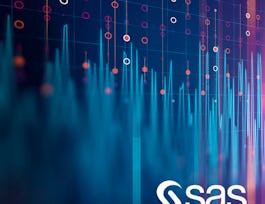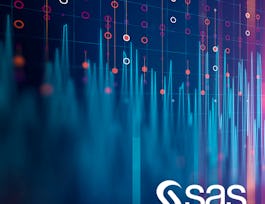This introductory course is for SAS software users who perform statistical analyses using SAS/STAT software. The focus is on t tests, ANOVA, and linear regression, and includes a brief introduction to logistic regression.



(293 reviews)
Skills you'll gain
Details to know

Add to your LinkedIn profile
61 assignments
See how employees at top companies are mastering in-demand skills


Earn a career certificate
Add this credential to your LinkedIn profile, resume, or CV
Share it on social media and in your performance review

There are 8 modules in this course
In this module you learn about the course and the data you analyze in this course. Then you set up the data you need to do the practices in the course.
What's included
2 videos4 readings
In this module you learn about the models required to analyze different types of data and the difference between explanatory vs predictive modeling. Then you review fundamental statistical concepts, such as the sampling distribution of a mean, hypothesis testing, p-values, and confidence intervals. After reviewing these concepts, you apply one-sample and two-sample t tests to data to confirm or reject preconceived hypotheses.
What's included
17 videos2 readings9 assignments
In this module you learn to use graphical tools that can help determine which predictors are likely or unlikely to be useful. Then you learn to augment these graphical explorations with correlation analyses that describe linear relationships between potential predictors and our response variable. After you determine potential predictors, tools like ANOVA and regression help you assess the quality of the relationship between the response and predictors.
What's included
29 videos2 readings14 assignments
In this module you expand the one-way ANOVA model to a two-factor analysis of variance and then extend simple linear regression to multiple regression with two predictors. After you understand the concepts of two-way ANOVA and multiple linear regression with two predictors, you'll have the skills to fit and interpret models with many variables.
What's included
13 videos1 reading5 assignments
In this module you explore several tools for model selection. These tools help limit the number of candidate models so that you can choose an appropriate model that's based on your expertise and research priorities.
What's included
11 videos3 readings4 assignments
In this module you learn to verify the assumptions of the model and diagnose problems that you encounter in linear regression. You learn to examine residuals, identify outliers that are numerically distant from the bulk of the data, and identify influential observations that unduly affect the regression model. Finally, you learn to diagnose collinearity to avoid inflated standard errors and parameter instability in the model.
What's included
18 videos7 assignments
In this module you learn how to transition from inferential statistics to predictive modeling. Instead of using p-values, you learn about assessing models using honest assessment. After you choose the best performing model, you learn about ways to deploy the model to predict new data.
What's included
11 videos1 reading4 assignments
In this module you look for associations between predictors and a binary response using hypothesis tests. Then you build a logistic regression model and learn about how to characterize the relationship between the response and predictors. Finally, you learn how to use logistic regression to build a model, or classifier, to predict unknown cases.
What's included
25 videos18 assignments
Instructor

Offered by
Why people choose Coursera for their career




Learner reviews
293 reviews
- 5 stars
82.93%
- 4 stars
12.28%
- 3 stars
2.38%
- 2 stars
0.68%
- 1 star
1.70%
Showing 3 of 293
Reviewed on May 1, 2022
The course was very useful to reinforce the basics of Statistics. The real life examples to drive the concepts were very good and easy to understand
Reviewed on May 22, 2020
A Guided lesson even for a beginner. It gives you a general overview of statistics with great emphasis on SAS programming and statistical interpretations of your analyses.
Reviewed on Feb 7, 2023
The best part about this course was how well he explained the different types of statistical studies in general and also with the examples. Very very useful. A must take course for every statistician.
Recommended if you're interested in Data Science

Open new doors with Coursera Plus
Unlimited access to 10,000+ world-class courses, hands-on projects, and job-ready certificate programs - all included in your subscription
Advance your career with an online degree
Earn a degree from world-class universities - 100% online
Join over 3,400 global companies that choose Coursera for Business
Upskill your employees to excel in the digital economy





